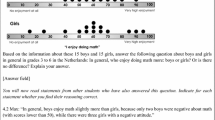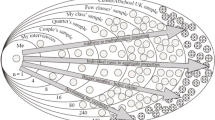Abstract
While aggregate reasoning is a core aspect of statistical reasoning, its development is a key challenge in statistics education. In this study we examine how students’ aggregate reasoning with samples and sampling (ARWSS) can emerge in the context of statistical modeling activities of real phenomena. We present a case study on the emergent ARWSS of two pairs of sixth graders (age 11–12) involved in statistical data analysis and informal inference utilizing TinkerPlots. The students’ growing understandings of various statistical concepts is described and five perceptions the students expressed are identified. We discuss the contribution of modeling to these progressions followed by conclusions and limitations of these results. While idiosyncratic, the insights contribute to the understanding of students’ aggregate reasoning with data and models, with regards to samples and sampling.















Similar content being viewed by others
Notes
For a detailed description of the 2015 iteration, see the chapter by Aridor and Ben-Zvi (2018).
The three schools were the students’ primary school, another primary school from the same area and a middle school which is also the future school of these two primary schools.
The sample data in the second and third cycles were collected randomly using a raffle planned by the students. For n = 60, data were collected from 15 grade 2, 4 and 6 students from their school and 15 eighth graders from their future middle school; For n = 105, an additional 15 grade 2, 4 and 6 students from their school were involved.
For a detailed description of the 2016 activity sequence, please see the Connections Website: http://connections.edtech.haifa.ac.il/Research/connections2016LT.
Data were presented to and analyzed by the Connections research team, consisting of one Professor, one Doctor, two PhD students and three M.A. students. The authors of this paper are part of this team.
Each pair sampled from a similar population of strings. However, the strings̓ measurements were different as the strings were easily stretched.
References
Ainley, J., Pratt, D., & Hansen, A. (2006). Connecting engagement and focus in pedagogic task design. British Educational Research Journal, 32(1), 23–38.
Aridor, K., & Ben-Zvi, D. (2017). The co-emergence of aggregate and modelling reasoning. Statistics Education Research Journal, 16(2), 38–63.
Aridor, K., & Ben-Zvi, D. (2018). Students’ aggregate reasoning with covariation. In G. Burrill & D. Ben-Zvi (Eds.), Topics and trends in current statistics education research: International perspectives. New York: Springer (in press).
Bakker, A., & Gravemeijer, K. P. E. (2004). Learning to reason about distributions. In D. Ben-Zvi & J. Garfield (Eds.), The challenge of developing statistical literacy, reasoning, and thinking (pp. 147–168). Dordrecht: Kluwer.
Ben-Zvi, D., & Arcavi, A. (2001). Junior high school students’ construction of global views of data and data representations. Educational Studies in Mathematics, 45(1–3), 35–65.
Ben-Zvi, D., Aridor, K., Makar, K., & Bakker, A. (2012). Students’ emergent articulations of uncertainty while making informal statistical inferences. ZDM - The International Journal on Mathematics Education, 44(7), 913–925.
Ben-Zvi, D., Bakker, A., & Makar, K. (2015). Learning to reason from samples. Educational Studies in Mathematics, 88(3), 291–303.
Ben-Zvi, D., Gravemeijer, K., & Ainley, J. (2018). Design of statistics learning environments. In D. Ben-Zvi, K. Makar, & J. Garfield (Eds.), International handbook of research in statistics education (pp. 473–502). Cham: Springer Cham.
Biehler, R., Ben-Zvi, D., Bakker, A., & Makar, K. (2013). Technology for enhancing statistical reasoning at the school level. In M. A. Clements et al. (Eds.), Third international handbook of mathematics education (pp. 643–690). New York: Springer.
Garfield, J., & Ben-Zvi, D. (2008). Developing students’ statistical reasoning: Connecting research and teaching practice. New York: Springer.
Hancock, C., Kaput, J. J., & Goldsmith, L. T. (1992). Authentic enquiry with data: Critical barriers to classroom implementation. Educational Psychologist, 27(3), 337–364.
Konold, C. (2002). Teaching concepts rather than conventions. New England Journal of Mathematics, 34(2), 69–81.
Konold, C., Higgins, T., Russell, S.-J., & Khalil, K. (2015). Data seen through different lenses. Educational Studies in Mathematics, 88(3), 305–325.
Konold, C., & Kazak, S. (2008). Reconnecting data and chance. Technology innovations in statistics education, 2(1), 1, (article 1).
Konold, C., & Miller, C. (2015). TinkerPlots™ (Version 2.2) [Computer software]. Amherst: University at Massachusetts.
Konold, C., & Pollatsek, A. (2002). Data analysis as the search for signals in noisy processes. Journal for Research in Mathematics Education, 33(4), 259–289.
Lehrer, R., & English, L. (2018). Introducing children to modeling variability. In D. Ben-Zvi, K. Makar, & J. Garfield (Eds.), International handbook of research in statistics education (pp. 229–260). Cham: Springer Cham.
Lehrer, R., & Schauble, L. (2004). Modelling natural variation through distribution. American Educational Research Journal, 41(3), 635–679.
Lehrer, R., & Schauble, L. (2005). Developing modeling and argument in the elementary grades. In T. Romberg, T. Carpenter & F. Dremock (Eds.), Understanding mathematics and science matters (pp. 29–53). Mahwah: Erlbaum.
Makar, K., Bakker, A., & Ben-Zvi, D. (2011). The reasoning behind informal statistical inference. Mathematical Thinking and Learning, 13(1), 152–173.
Makar, K., & Rubin, A. (2018). Learning about statistical inference. In D. Ben-Zvi, K. Makar, & J. Garfield (Eds.), International handbook on research in statistics education. (pp. 261–294). Cham: Springer Cham.
Manor, H., & Ben-Zvi, D. (2017). Students’ emergent articulations of statistical models and modeling in making informal statistical inferences. Statistics Education Research Journal, 16(2), 116–143.
Moore, D. S. (2010). The basic practice of statistics. New York: Freeman.
Pfannkuch, M., Ben-Zvi, D., & Budgett, S. (2018). Innovations in statistical modeling to connect data, chance and context. ZDM Mathematics Education, 1, 1–11.
Rubin, A., Bruce, B., & Tenney, Y. (1991). Learning about sampling: Trouble at the core of statistics. In D. Vere-Jones (Ed.), Proceedings of the Third International Conference on Teaching Statistics (Vol. 1, pp. 314–319). Amsterdam: ISI Publications in Statistical Education.
Rubin, A., Hammerman, J. K. L., & Konold, C. (2006). Exploring informal inference with interactive visualization software. In Proceedings of the Seventh International Conference on Teaching Statistics. Salvador, Brazil.
Schoenfeld, A. H. (2007). Method. In F. Lester (Ed.), Second handbook of research on mathematics teaching and learning (pp. 69–107). Charlotte: Information Age Publishing.
Shaughnessy, M., & Chance, B. (2005). Statistical questions from the classroom. Reston: NCTM.
Siegler, R. S. (2006). Microgenetic analyses of learning. In D. Kuhn & R. S. Siegler (Eds.), Handbook of child psychology: Cognition, perception, and language (Vol. 2, 6th edn., pp. 464–510). Hoboken: Wiley.
Acknowledgements
This research was supported by the University of Haifa and the I-CORE Program of the Planning and Budgeting Committee and the Israel Science Foundation Grant 1716/12. We deeply thank the Connections research team and the anonymous reviewers of earlier versions of this manuscript.
Author information
Authors and Affiliations
Corresponding author
Rights and permissions
About this article
Cite this article
Aridor, K., Ben-Zvi, D. Statistical modeling to promote students’ aggregate reasoning with sample and sampling. ZDM Mathematics Education 50, 1165–1181 (2018). https://doi.org/10.1007/s11858-018-0994-5
Accepted:
Published:
Issue Date:
DOI: https://doi.org/10.1007/s11858-018-0994-5




